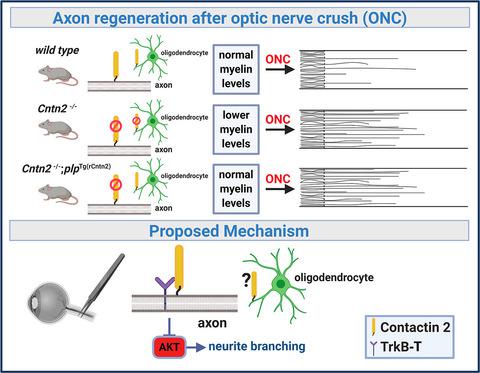当前位置:
X-MOL 学术
›
Eur. J. Neurosci.
›
论文详情
Our official English website, www.x-mol.net, welcomes your feedback! (Note: you will need to create a separate account there.)
Neuronal, but not glial, Contactin 2 negatively regulates axon regeneration in the injured adult optic nerve
European Journal of Neuroscience ( IF 3.698 ) Pub Date : 2021-01-20 , DOI: 10.1111/ejn.15121 Maria Savvaki 1, 2 , George Kafetzis 3, 4 , Stefanos‐Ioannis Kaplanis 1, 2 , Niki Ktena 1, 2 , Kostas Theodorakis 2 , Domna Karagogeos 1, 2
European Journal of Neuroscience ( IF 3.698 ) Pub Date : 2021-01-20 , DOI: 10.1111/ejn.15121 Maria Savvaki 1, 2 , George Kafetzis 3, 4 , Stefanos‐Ioannis Kaplanis 1, 2 , Niki Ktena 1, 2 , Kostas Theodorakis 2 , Domna Karagogeos 1, 2
Affiliation

|
Mammalian adult neurons of the central nervous system (CNS) display limited ability to regrow axons after trauma. The developmental decline in their regenerative ability has been attributed to both intrinsic and extrinsic factors, including postnatal suppression of transcription factors and non‐neuronal inhibitory components, respectively. The cell adhesion molecule Contactin 2 (CNTN2) is expressed in neurons and oligodendrocytes in the CNS. Neuronal CNTN2 is highly regulated during development and plays critical roles in axon growth and guidance and neuronal migration. On the other hand, CNTN2 expressed by oligodendrocytes interferes with the myelination process, with its ablation resulting in hypomyelination. In the current study, we investigate the role of CNTN2 in neuronal survival and axon regeneration after trauma, in the murine optic nerve crush (ONC) model. We unveil distinct roles for neuronal and glial CNTN2 in regenerative responses. Surprisingly, our data show a conflicting role of neuronal and glial CNTN2 in axon regeneration. Although glial CNTN2 as well as hypomyelination are dispensable for both neuronal survival and axon regeneration following ONC, the neuronal counterpart comprises a negative regulator of regeneration. Specifically, we reveal a novel mechanism of action for neuronal CNTN2, implicating the inhibition of Akt signalling pathway. The in vitro analysis indicates a BDNF‐independent mode of action and biochemical data suggest the implication of the truncated form of TrkB neurotrophin receptor. In conclusion, CNTN2 expressed in CNS neurons serves as an inhibitor of axon regeneration after trauma and its mechanism of action involves the neutralization of Akt‐mediated neuroprotective effects.
中文翻译:

神经元,但不是神经胶质,Contactin 2负调节成年成年视神经中的轴突再生
中枢神经系统(CNS)的哺乳动物成年神经元显示出创伤后轴突再生的能力有限。它们再生能力的发展下降归因于内在和外在因素,包括出生后分别抑制转录因子和非神经抑制成分。细胞粘附分子Contactin 2(CNTN2)在中枢神经系统的神经元和少突胶质细胞中表达。神经元CNTN2在发育过程中受到高度调节,并在轴突生长和引导以及神经元迁移中起关键作用。另一方面,少突胶质细胞表达的CNTN2干扰髓鞘形成过程,其消融导致髓鞘减少。在目前的研究中,我们调查了CNTN2在创伤后神经元存活和轴突再生中的作用,在小鼠视神经挤压(ONC)模型中。我们揭示了神经元和神经胶质CNTN2在再生反应中的独特作用。令人惊讶的是,我们的数据显示神经元和神经胶质CNTN2在轴突再生中的冲突作用。尽管神经胶质CNTN2以及低髓鞘作用对于ONC后的神经元存活和轴突再生都是必不可少的,但神经元对应物却包含负的再生调节剂。具体来说,我们揭示了神经元CNTN2的新型作用机制,这牵涉到Akt信号通路的抑制作用。体外分析表明不依赖BDNF的作用方式,生化数据表明TrkB神经营养蛋白受体的截短形式具有潜在意义。综上所述,
更新日期:2021-01-20
中文翻译:

神经元,但不是神经胶质,Contactin 2负调节成年成年视神经中的轴突再生
中枢神经系统(CNS)的哺乳动物成年神经元显示出创伤后轴突再生的能力有限。它们再生能力的发展下降归因于内在和外在因素,包括出生后分别抑制转录因子和非神经抑制成分。细胞粘附分子Contactin 2(CNTN2)在中枢神经系统的神经元和少突胶质细胞中表达。神经元CNTN2在发育过程中受到高度调节,并在轴突生长和引导以及神经元迁移中起关键作用。另一方面,少突胶质细胞表达的CNTN2干扰髓鞘形成过程,其消融导致髓鞘减少。在目前的研究中,我们调查了CNTN2在创伤后神经元存活和轴突再生中的作用,在小鼠视神经挤压(ONC)模型中。我们揭示了神经元和神经胶质CNTN2在再生反应中的独特作用。令人惊讶的是,我们的数据显示神经元和神经胶质CNTN2在轴突再生中的冲突作用。尽管神经胶质CNTN2以及低髓鞘作用对于ONC后的神经元存活和轴突再生都是必不可少的,但神经元对应物却包含负的再生调节剂。具体来说,我们揭示了神经元CNTN2的新型作用机制,这牵涉到Akt信号通路的抑制作用。体外分析表明不依赖BDNF的作用方式,生化数据表明TrkB神经营养蛋白受体的截短形式具有潜在意义。综上所述,


























 京公网安备 11010802027423号
京公网安备 11010802027423号